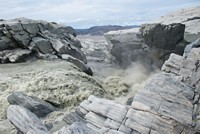Advertisement
Grab your lab coat. Let's get started
Welcome!
Welcome!
Create an account below to get 6 C&EN articles per month, receive newsletters and more - all free.
It seems this is your first time logging in online. Please enter the following information to continue.
As an ACS member you automatically get access to this site. All we need is few more details to create your reading experience.
Not you? Sign in with a different account.
Not you? Sign in with a different account.
ERROR 1
ERROR 1
ERROR 2
ERROR 2
ERROR 2
ERROR 2
ERROR 2
Password and Confirm password must match.
If you have an ACS member number, please enter it here so we can link this account to your membership. (optional)
ERROR 2
ACS values your privacy. By submitting your information, you are gaining access to C&EN and subscribing to our weekly newsletter. We use the information you provide to make your reading experience better, and we will never sell your data to third party members.
Art & Artifacts
Ice cores may have tracked ancient Rome’s boom and bust
Traces of lead pinpoint economic activity, but doubts about contamination have been raised
by Katharine Sanderson, special to C&EN
May 21, 2018

Traces of lead trapped in the ice of our planet’s coldest reaches are helping historians pinpoint times of economic prosperity and decline in antiquity.
Ice cores from Greenland and elsewhere have been used to help scientists track what happened to Earth’s climate in the past and so model what might happen in future. But historians are also getting in on the act. The latest results reveal details about lead pollution, which is linked to silver production and the economic strength of the peoples making it (Proc. Natl. Acad. Sci. USA 2018, DOI: 10.1073/pnas.1721818115).
Joseph R. McConnell from the Desert Research Institute in Reno, Nev., and his team took an in-depth look at a 423-meter-long ice core obtained from the North Greenland Ice Core Project. Using two high-resolution inductively coupled plasma mass spectrometers, the team measured levels of lead deposited in the ice core for almost every year between 1100 BCE and 800 CE. For this kind of lead analysis, “these new measurements are by far the highest time-resolution records during antiquity,” McConnell says.
The changes in levels of lead in the ice, the authors say, link well to various periods of European history. Lead levels dropped away significantly around the last years of the Roman Republic, coinciding with a time of war and so less lead-silver ore smelting. Conversely, when the Roman Empire was at its height, the researchers found four times as much lead deposited, suggesting that more smelting was happening.
McConnell says his team knew that the lead was most likely from southern Europe because of lead isotope measurements performed previously, archaeological studies that uncovered large lead and silver mines in the Iberian Peninsula, and atmospheric modeling. “It is pretty amazing that detectable lead pollution from Western Mediterranean emissions was falling on Greenland 2,800 years ago,” McConnell says.
However, Claude Boutron, retired atmospheric chemist from Joseph Fourier University (now part of the University of Grenoble), isn’t yet convinced that the lead measured by McConnell can be unequivocally attributed to lead from Roman smelting. Boutron, who was not involved with the work, disagrees with the authors’ assertion that they removed the chance of lead contamination by discounting measurements from obviously cracked ice samples along the core. “Outside contamination often penetrates to the center of the core through micro cracks which cannot be seen by eye,” Boutron says.
McConnell remains confident in his study, saying that his team’s lead emissions measurements agree with others published in the 1990s. McConnell says the team estimated the magnitude of the emissions based on state-of-the-art atmospheric transport modeling, and their measurements agree with previous estimates based on archaeological and historical evidence. “This would not be true if our measurements were significantly contaminated by the elusive invisible cracks,” he says.
Next, McConnell says he hopes to turn his attention to the links between climate and society—including the impacts of volcanic eruptions on ancient societies.



Join the conversation
Contact the reporter
Submit a Letter to the Editor for publication
Engage with us on Twitter